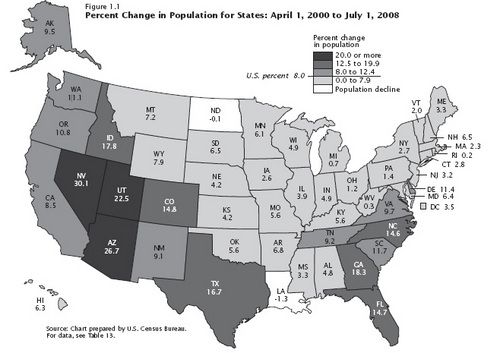The Census Bureau today is out with its 2010 abstracts, snapshots of the country in just about every imaginable category.
For example, population (Click for larger image):
Minnesota has gained population in this decade, but is it enough to prevent losing one member of Congress to the Southwest? Perhaps. Michigan might lose representation. North Dakota is one of only two states losing population. Louisiana has Hurricane Katrina to blame. What’s North Dakota’s excuse?
Other factoids from today’s release:
— The percentage of Minnesotans with a high school degree or more has increased by 2.1% this decade, to 91%. Only Wyoming (91.2%) is better. Texas is the worst state in the nation in this category (79.1%)
— Minneapolis is far and away the safest city when it comes to the prevalence of rape. One for every 121.8 per 100,000 people. Would you believe that Cleveland is the safest city when it comes to robberies? (This is wrong. See comments.)
— For 2006, 2007 and 2008, federal aid to cities and states dropped. It’s projected to jump 23.9% this year (presumably because of the stimulus). The previous record increases were during the first three years of the Bush administration.
— In the first six years of the decade, Minnesota revenue increased almost 26%. Over the same period, state spending increased 26.5%. In Minneapolis, a family of three making $25,000 paid 10.7 percent of their income in state and local taxes. That ranks 26th among the nation’s big cities. A family of three making $150,000 paid 9.7%. That ranks 13th in the nation.
— Minneapolis ranks 34th in the nation in property taxes, in a category of the largest city in each state. Bridgeport, Connecticut is the most expensive in this category.
— Minnesota state workforce has increased by 6.8% this decade. Local government employment has dropped by 1 percent. State worker earnings have increased 23.5%. City and county workers earnings have increased about 24% (through 2007).
— In current dollars, Minnesotans personal income has risen 41% this decade. Adjusted for inflation, it’s increased 16%. Minnesota ranks 10th in the nation in personal income. That rank hasn’t changed in this decade. By contrast, Wisconsin has dropped from #19 to #27. Minneapolis-St. Paul-Bloomington’s personal income jumped 6.7 percent from ’06 to ’07. That ranks 14th among 60 metro areas.
— 11.9% of Minnesota’s bridges are “deficient and obsolete.” Sounds bad, right? It’s second-best in the nation. 60.5% of the District of Columbia’s bridges fall into the same category.
— Traffic congestion in the Twin Cities cost each person 15 gallons of fuel per year, and wastes 22 hours. That’s exactly average for the nation as a whole. The average travel time to work in Minnesota is 22 minutes.
— Thirty-one percent of Minnesota’s highway fatalities involved drunk driving. That’s 31st in the nation.
— The highest percentage of “participation” in classical music activities in the U.S. is the 18-to-24 year age group. But the highest percentage of people who go to a classical music concert are between 65 and 74 and make more than $150,000 a year. The highest percentage (by education level) of people who go to sporting events are college graduates.

